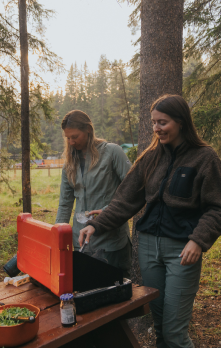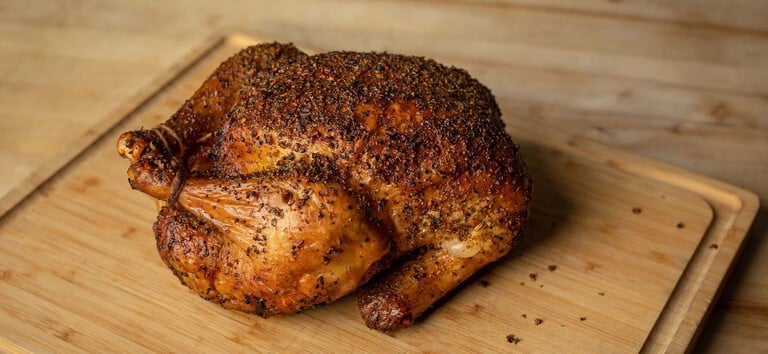
THE BOOK OF CHICKEN
Chicken is one of the most popular meats as it's both a tasty and cost-effective meal option, not to mention once of the healthiest sources of protein. You can find great deals year-round at your local supermarket on wings, breast, etc. But, have you explored the numerous cuts, cooking methods, and marinades that make chicken a family favorite?
Chapter Links
CHICKEN ANATOMY
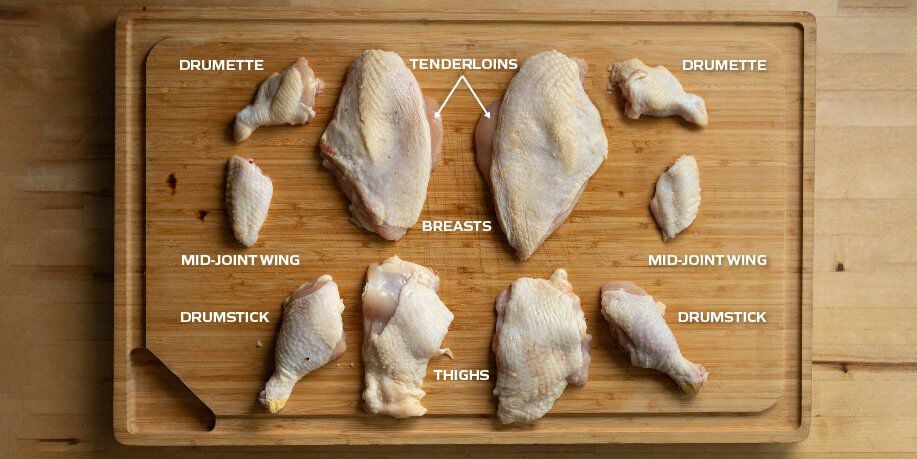
So, what really came first? The chicken or the egg? Enough with the cluck. Let's take a moment to first break down the different components of a chicken and the most popular on at the market.
Whole / Halved / Quarter
Cooking a whole chicken works great for feeding the family. You can smoke it and use for meal prep or store and make multiple tasty meals throughout the week. Be prepared for more cuts and slicing after smoking a whole chicken. An 8-cut chicken is in reference to a chickens 2-drumsticks, 2-thighs, and 2-breasts cut in half across the rib bone (one could contain the wing.)
Wings / Drumette / Flat
Typically, one of the cheaper cuts of the chicken, these are typically fried and eaten as America's favorite finger foods. Chicken wings, drumettes, and flats are distinct and delectable parts of the chicken wing that have become beloved appetizers and snacks. Each portion offers its own unique characteristics and eating experience. Chicken wings consist of three parts: the drumette, the flat, and the tip. The drumette is the meatier section, resembling a small drumstick, while the flat is the middle section that contains two parallel bones with tender meat in between. The tip, although less meaty, adds flavor and can be used to make stocks or broths.
Leg / Drumstick
Chicken drumsticks have a juicy and tender texture, especially when properly cooked. The meat is typically darker and richer in flavor compared to chicken breast meat. This is because the drumstick is a muscle that gets exercised more, resulting in increased blood flow and higher myoglobin content, which contributes to its darker color and robust flavor.
Breast / Tenderloin
One of the most commonly bought cuts is the chicken breast. It's most widely used in cooking due to its low-fat content and ease of slicing for multiple meal options. When butchering a whole chicken, the tenderloin is found on the innermost muscle of the breast lying along the breastbone. Tenderloins are more tender when compared to the breast.
Thigh
Either bought as fillets or cutlets, the chicken thighs are brown meat. They're higher fat content gives them built in flavor for all types of dishes. You may need to invest a little more time into the trimming aspect to get just the right meat to fat ratio. Chicken thighs are highly regarded in culinary circles due to their ability to retain moisture and flavor during cooking. This makes them excellent for various cooking methods such as baking, grilling, sautéing, or braising. Their higher fat content ensures that the meat remains moist and flavorful, even after prolonged cooking times.
WHITE MEAT VS. DARK MEAT
You've probably heard of white meat vs. dark meat. This is in reference to the amount of red fibers found within the muscle. The only real difference is when it comes to cook times and flavor.
White Meat
The white meat of the chicken will contain mostly white fibers (10% red.) You'll find white meat in the breast and wings. This will dry out very easily if overcooked. While the difference is minuscule, white meat contains more lean protein. It's a great option for those following a low-fat diet.
Dark Meat
The dark meat of the chicken will contain more red fibers (50% red.) This is mostly found in the drumsticks, legs, and thighs. Because the dark meat contains more inner muscle fat content you'll find it's a more flavorful part of the chicken. This added fat allows for a wider internal temperature range (175-190°F.) Dark meat also contains higher levels of iron, vitamin b, vitamin c, and zinc. Giving you a great exposure to nutrients. Connective tissue.
TRIMMING
Chickens are known for being a lean clean protein so is it even necessary to trim them? Yes, it is important to trim them but not quite the same as beef or pork. Chickens still have tendons that can be left behind from the store. Thighs might actually have some fat that you would like to trim off as well. Even though a chicken isn't known for being fatty, fat isn't the only thing you are looking for to trim.
Skin on or off
Historically, health nuts will trim the skin off with the idea that most of the fat resides in the skin. A skin-on chicken will cook differently than a skin-off chicken in the way that the skinless will cook faster. Keep in mind that you have a greater chance of losing moisture during the cooking process if your chicken is skinless.
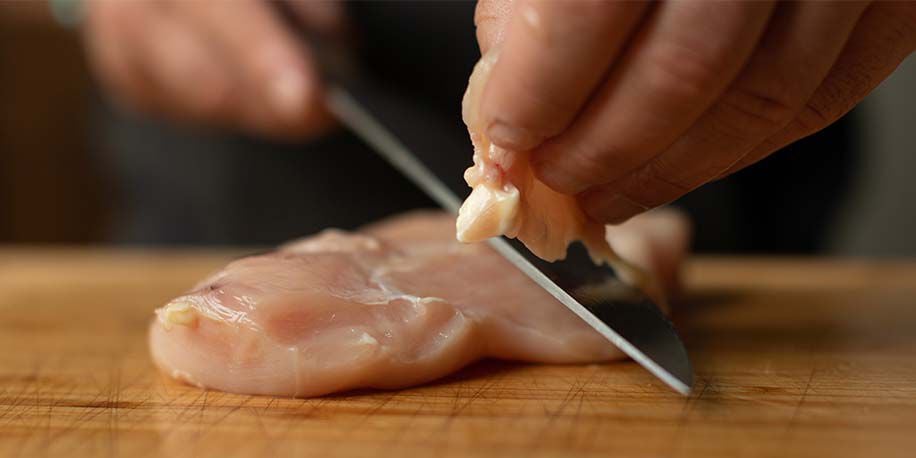
Trimming Chicken Breasts
There is a good amount of people who don't bother trimming chicken. However, on chicken breasts between fat, tendon, and some discolorations some cuts might be worth the extra work. Simply use a sharp knife, locate the hard-white fat, and cut it out.
Trimming Tenderloins
If you're cooking with tenderloins and plan to remove those tendons there's a great tip to its extraction. Using a fork, put the tendon between the fork's prongs. Grab the tendon using your other hand (and a paper towel for added grip) and slide the fork down the meat.
COOKING METHODS
GAS OR CHARCOAL GRILLS
The sweetheart of any summer meal is a grilled chicken. Whether it's in the form of a kabob or just a couple breasts lined up on the grates. You'll find that flame grilling is a quick and flavorful way to cook your chicken cuts. Be prepared for flare ups and constantly tending to your meat. We've got a number of cooking systems that include a BBQ box or griddle for grilling chicken.
PELLET GRILL + HYBRID COOKING
Smoked chicken is a great way to infuse your bird with flavor. The greatest amount of flavor comes when smoking at a lower temperature by using a pellet grill or vertical smoker. We recommend doing a hybrid smoking then grilling method. Smoking a chicken for an extended period of time can lead to a rubbery bird. So, smoke first, then turn up your pellet grill (or use your Slide and Grill knob) to a higher temperature setting to crisp up the skin. This way the fat start to render and break down giving you juicy on the inside, crispy on the outside. If you have the time and resources to smoke your chicken, try it out!
FLAME BROILED WITH SLIDE & GRILL PELLET GRILLS
One of our favorite methods over the last few years of its patented Camp Chef birth is cooking burgers directly over a wood-fire flame. On our product line, this can only be found in our Slide and Grill ("SG") enabled pellet grills. (To find out if your Camp Chef pellet grill is SG friendly, check the side of your grill chamber for a black knob with the words "Grill Knob" denoted in orange. By pulling this knob, the heat deflector plate slides away revealing direct flames.) Using the flame broil method on your Camp Chef pellet grill grants your chicken access to a deliciously, crispy taste of charbroiled flare. Keep in mind that flame broiled chicken aren't only found on pellet grills. The same fire kissed cooking style can be achieved on propane and charcoal grills-even over a campfire. All you need is a controlled fire source, a grill grate, and your chicken.
OVEN-BAKED
Probably the most common cooking method for chicken is oven-baked. It's simple and most households come standard with an oven. On the flip side, baked chicken lacks in flavor so you'll really have to focus on a good marinade/seasoning pairing as it's a pretty bland cooking method. If you camp often and wish you could take fresh oven-baked chicken with you, add an Outdoor Oven to your cooking collection!
DEEP FRIED
Of course, you've heard of fried chicken! But, have you tried your hand at homemade? Many get discouraged by the daunting thought of large pots of bubbling oils, but it's much simpler than that. You'll develop a crispy crust using a simple batter mix and cooking oils. A cooking system or Sidekick pellet grill attachment allows for you to add a pot for fried chicken. Use the same hybrid method we talked about above. Smoke, then fry your chicken for the best result.
THAWING
There are many ways to thaw a chicken but what is the best? Best is always a subjective term. We may not be able to tell you what is best but we can tell you our favorites.
Refrigerator Method
Keep the chicken in its original wrapping and place it in a fridge set to 40°F or below. You can typically account for 6 hours / pound. If you get used to thawing chicken be careful not to underestimate a turkey in the fridge. They might both be poultry but they are very different in size and time needed to thaw.
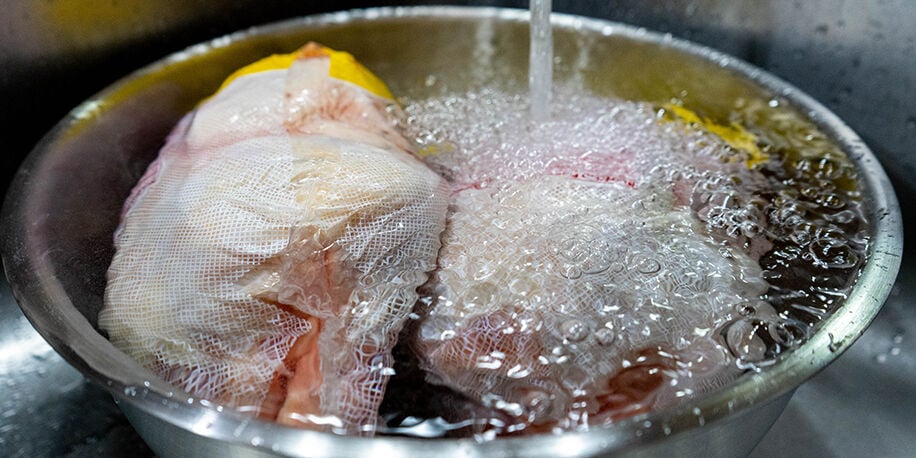
Cold Water Method
In its original wrapping, submerge the chicken in cold water. Replace the water with cold water every half hour or so. A large sink, bucket, or pot works well for this method. If you are unsure you have a large enough pot to hold your chicken try the 24 qt. or 32 qt. aluminum pots. You can typically account for 30 minutes / pound.
Short On Time
If you've forgotten to thaw those chicken breast, thighs, wings or legs-don't stress! In fact, smoke adheres well to a cold bird. Just set your grill to Low Smoke, then placing the frozen chicken directly on the grate. After about 30 minutes, the surface area is wet enough for seasoning. Let it smoke and thaw for another 30 minutes and then continue to cook as you normally would. (This method is not recommended for full birds due to the size and food safety temps.)
WOOD
Different woods burn differently and not just any variety hardwood will do for chicken. If you're looking for a classic bold flavor we recommend a Mesquite or Oak pellet base. If you're looking for something on the sweeter side try a Cherry or Apple. And if you're unsure about which hardwood pellets to commit to, the Competition Blend is a safe route.
In our Pro series pellet grills and smokers you can use hardwood chips or chunks. The Woodwind Pro and XXL Pro have our new technology which give significantly more smoke flavor rivaling that of an offset stick smoker. The chips and chunks burn slightly "dirtier". This is where the majority of the flavor comes from. Pellet grills are amazing at flavor and convenience but critics will say they don't provide enough smoke flavor. If you are considering what wood to use and have the capability of picking up a Pro series pellet grill or vertical smoker, the wood you put in the smoke box will determine the ending flavor.
SEASONINGS + SAUCES + MARINADES
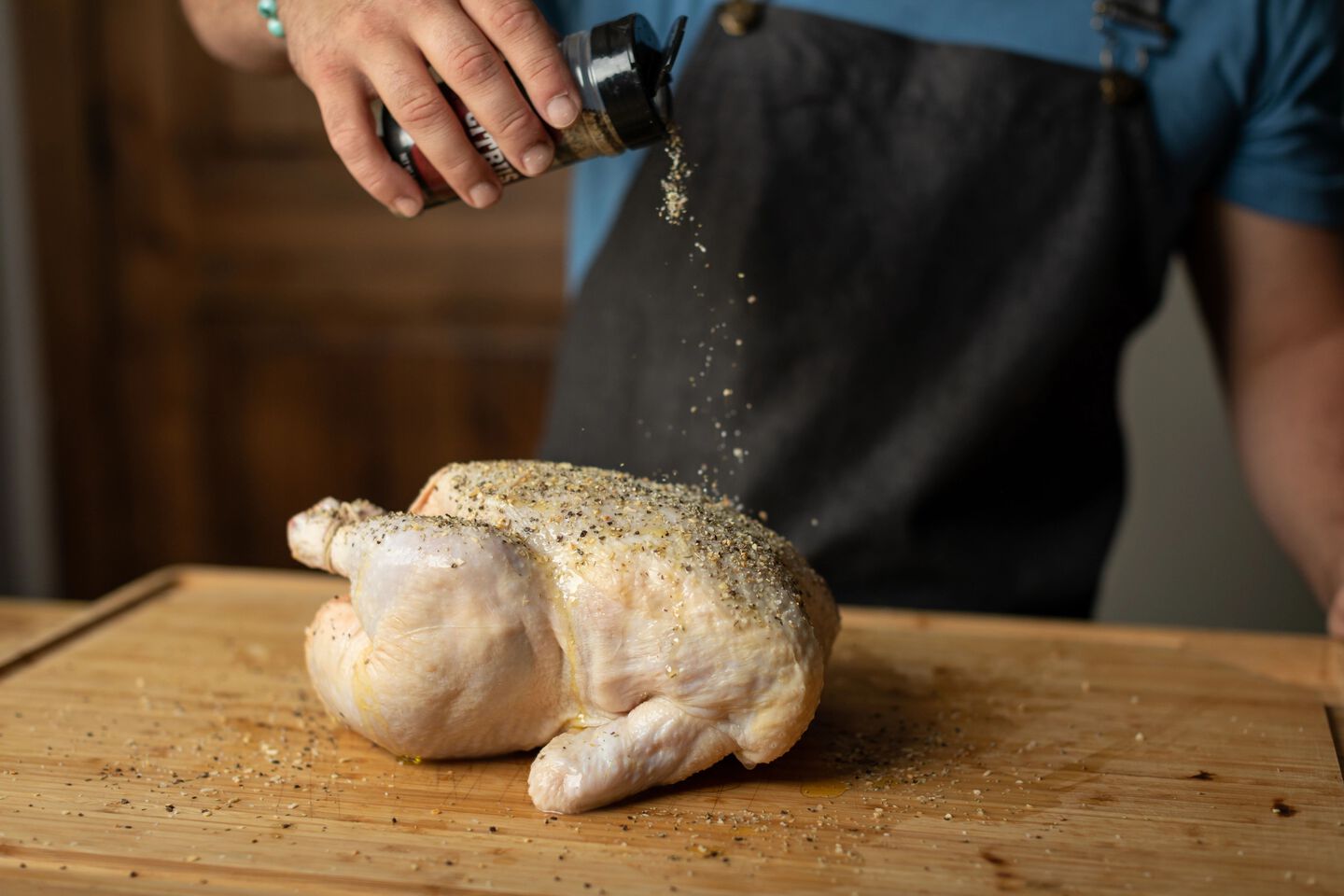
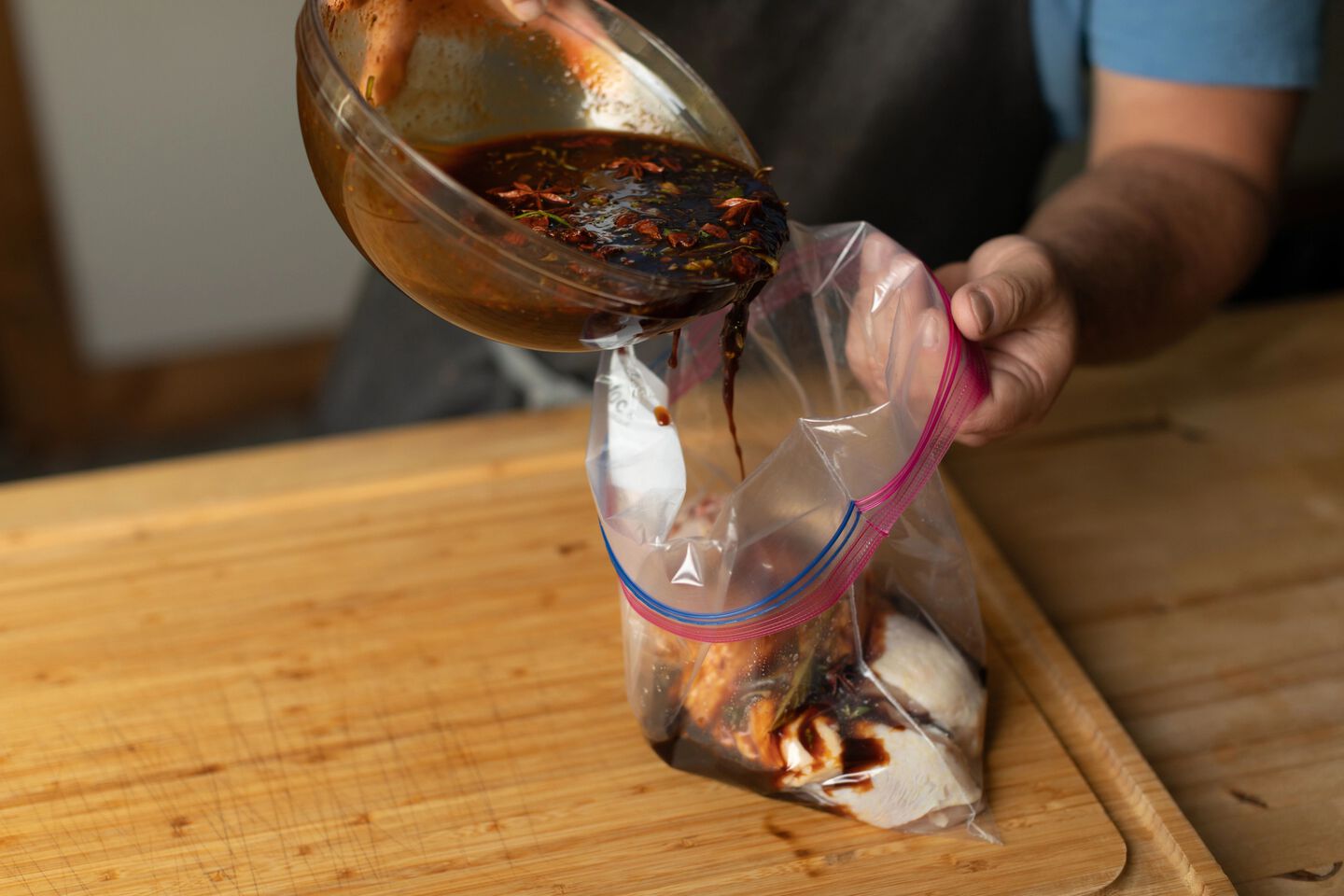
Dry Brining
Seasoning a chicken (or dry brining) is the same as a turkey! Combine a variety of dry seasonings in a bowl then sprinkle/rub directly on the meat. You can do this immediately before you pop your chicken into your oven or smoker or leave it on for an extended period of time before cooking (24-72 hours.) Keep in mind, chicken is a blank canvas that will take to a number of different flavors, the sky is the limit! When it comes to grilled chicken, you can keep it simple. By opting to leave the skin on you're maintaining that fat, which is built in flavor!
Wet Brining
Similar to wet brining, marinating a chicken is a popular method that adds flavor to your bird. It's the process of adding seasonings to acidic liquids (wine, vinegar, lemon juice, etc.) and soaking your meat for hours. The acidic liquid also tenderizes the meat by breaking down the connective tissues. Different cuts of meat may require more or less time during the soaking process. Careful to not let them sit too long, some tender cuts might turn soft and mushy. Between 30 minutes and 3-4 hours is acceptable.
Sauces
Sauce is a whole other ball game! You often hear sauces and chicken in the same sentence when referencing killer wings. Between big box stores, locally bottled, or your own secret recipe, there's no shortage of sauces that pair well with chicken. Use it at the end for dipping/serving or brush it on during the last 10-15 minutes of grilling for a caramelized twist.
TIME + TEMP
What's best and what's safe
There's only two temperatures you need to worry about, what tastes best and what's safe. If you follow our recipe blog, you'll notice that we don't present exact cook times. We know that every piece of meat is different, and cooks differently. Depending on size, cut, and cooking method, nothing can be exact. We cannot stress enough that the only way to ensure accurate temperature readings is by monitoring your chicken's internal temperature using a thermometer or included meat probe. The USDA advises bringing your chicken to 165°F to eliminate the presence of salmonella. However, chicken thighs hit their peak taste when they've reached 175-190°F. Grilled chicken breasts on a propane and charcoal grill may only take 10-15 minutes. Smoking them on a pellet grill at 225°F can be anywhere from an hour to an hour and a half. Whereas, oven baked breasts at 350-400°F can be around 20-35 minutes. Just like other popular cuts of meat, bones will add more cooking time to your bird. And, of course whole chickens will take longer in every category to cook all the way through.
RESTING
Chicken can absolutely benefit from a little rest. By resting your chicken 5-10 minutes it allows the juices to redistribute properly. No matter the meat or cut keep in mind resting is one of the most important steps. This allows the fibers to relax. Resting is always important.
SLICING
You'll likely only be focused on slicing if you cooked a whole chicken. If that's the case, it's identical to carving a turkey. Here are a few easy steps to follow if you are in charge of carving the chicken.
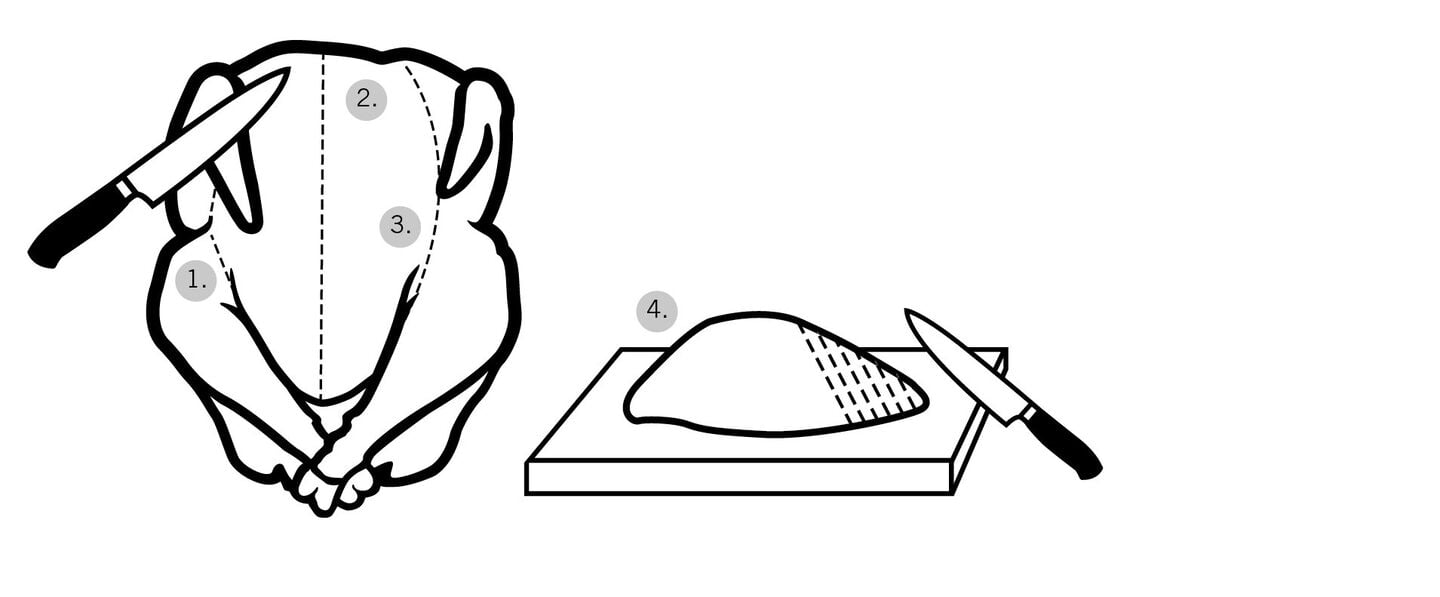
- Remove the leg and wings by cutting at the joint where it meets the body.
- Cut along the backbone.
- Cut in from the side and meet the cut made along the backbone (from step 2.)
- Lift out the entire breast and slice against the grain.

Serving
Serving chicken is one of the most simple dishes. It pairs with nearly any side and as long as you followed our tips it will be juicy and delicious. You can separate the dark meat from the white meat to allow those who want a more distinct flavor chose the dark meat and those who don't can chose the white meat.
Recipes
Camp Chef has some killer chicken recipes. Try our Whole Roasted Lemon Herb Chicken, Chicken Vindaloo, Rosemary Chicken, and more.
Side Dishes
It's safe to say when planning a meal with chicken as your main entrée a vegetable dish will pair nicely. Try mushrooms, asparagus, carrots, green beans, potatoes, corn on the cob, or even a coleslaw. Carbs can be garlic bread, a healthy rice dish, etc. You really can't go wrong.
STORING + LEFTOVERS + REHEATING
Store chicken properly in the refrigerator for up to 4-5 days. It's easy to dry out the chicken when reheating. We suggest reheating in the oven or stove top when possible. Heat to 350°F or medium heat and add a couple tablespoons of water or stock to the bottom of the dish to create some moisture. Reheat until your chicken reaches an internal temperature of 165°F. Chicken also freezes well. You can freeze cooked chicken for up to three months.
As far as leftovers go, the possibilities are endless. Chicken noodle soup, Chicken Velvet Soup, tacos, chicken salad sandwiches, enchiladas, or chop and toss on a salad.
A CAMP CHEF CHICKEN
Camp Chef has a variety of products that help make chicken cooking seamless. Pick up the 26-inch Bamboo Cutting Board for a large surface great for trimming, seasoning, and slicing your chicken. All of our pellet grills have the capacity to smoke a whole chicken-even the Pursuit!
A Camp Chef-style chicken means more than just using our products-it also provides a sense of community. If you're on Facebook and have a Camp Chef pellet grill, join this customer-ran pellet grill group called Camp Chef Smoker Smokers.












